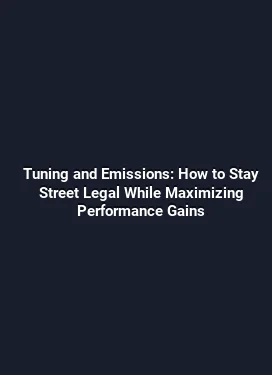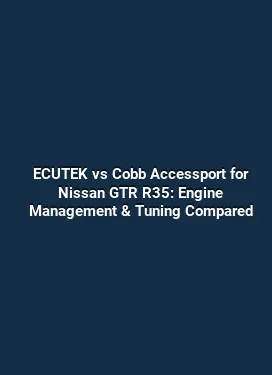Closed Loop vs Open Loop Tuning: When to Use Each Method
Engine management and tuning balance precision, safety, and performance. Two foundational approaches—closed loop tuning and open loop tuning—offer different advantages depending on operating conditions, goals, and hardware. Understanding how each method interprets sensor data, reacts to changes, and integrates with control strategies is essential for any tuner aiming to optimize power output, fuel efficiency, driveability, and reliability. This article delves into the practical distinctions, decision criteria, and real-world workflows that help determine the most effective tuning path for street cars, race vehicles, and performance builds.
Fundamental Concepts: How Closed Loop and Open Loop Control Work

At the core, closed loop tuning relies on feedback. A sensor network continuously monitors critical parameters such as air-fuel ratio (AFR), manifold pressure, and exhaust gas temperature, and the control system adjusts fuel delivery or ignition timing to maintain target values. Open loop tuning, by contrast, operates without live feedback for the parameter being controlled, following predefined maps or algorithms. The engine may still have feedback for other subsystems, but the target variable is dictated by a static model or lookup table during operation.
Practical implications flow from this distinction. Closed loop systems excel at maintaining consistent air-fuel ratio and stable operation across varying loads and environmental conditions. They adapt to sensor drift, fuel quality changes, and minor leaks. Open loop systems deliver predictable behavior in controlled environments where the operator wants to enforce a specific map, especially when sensor feedback is unreliable or intentionally suppressed for performance reasons. In real-world tuning, many setups use a hybrid approach, with open loop strategies under wide-open throttle (WOT) and closed loop control under cruising and part-throttle conditions.
Open Loop Tuning: When and How to Use It
Open loop tuning is often chosen for baseline calibrations, race scenarios with forced air-fuel targets, or when a sensor feedback loop is unavailable or degraded. The approach relies on predetermined fuel maps, ignition timing curves, and boost targets that do not adjust in real time to sensor feedback for the tuned parameter. The result is a repeatable, reproducible behavior that can be optimized for peak power, aggressive throttle response, or specific RPM ranges.
Key benefits include predictability and simplicity. With open loop, you can dial in peak cylinders headroom, optimize injector duty cycles for maximum torque, and implement aggressive boost strategies that reflect the limitations of hardware. The main risk is potential mismatch between target and actual operating conditions, which can lead to rich or lean mixtures, spark knock, or thermal stress if not carefully bounded.
Practical steps for effective open loop tuning: - Define a clear objective: peak power, throttle response, or fuel economy. - Develop a robust load- and RPM-based map that accounts for temperature, altitude, and fuel quality. - Use conservative safety margins to prevent detonation or lean runaway under transient events. - Validate maps on controlled data logging runs, then iteratively refine using real-world pulls and pull-downs.
First H3 Title: Key Characteristics of Open Loop Maps

Open loop maps typically emphasize gains in specific operating windows. The fuel map controls injector pulse width as a function of RPM and absolute load or air mass, while ignition tables adjust timing to maximize power without exceeding knock thresholds. Boost or turbocharger target levels may be bound by mechanical limits and intercooler performance, independent of feedback corrections. This separation makes it easier to push hardware boundaries, but it also requires rigorous testing to ensure safety under edge cases such as sudden throttle inputs or rapidly changing load.
Closed Loop Tuning: Core Advantages and Real-World Applications
Closed loop tuning introduces feedback control loops that continuously regulate targeted variables. The most common closed loop control in modern engines is AFR control via a wideband oxygen sensor. The engine control unit (ECU) compares the measured AFR to the target lambda value (the stoichiometric or tuned ratio) and adjusts fuel injector outputs to minimize error. Other closed loop strategies include idle speed control, variable valve timing on some platforms, and boost control where a pressure sensor informs the regulator or wastegate actuation.
The advantages of closed loop tuning are substantial. First, it compensates for environmental changes such as air density, humidity, and temperature, maintaining stable performance without manual re-basing. Second, it handles sensor drift because the feedback loop continuously corrects deviations. Third, it improves driveability by smoothing transitions between torque requests and keeping engine response predictable. For high-performance builds, closed loop control can work in harmony with open loop strategies in designated zones, providing a safety net without sacrificing peak capability.
Practical guidelines for effective closed loop tuning: - Ensure a high-quality wideband oxygen sensor with proper installation and calibration. - Establish safe AFR targets for the operating range and verify them under transient conditions. - Use data logging to characterize sensor response time, fuel trims, and lambda stability across RPM, load, and temperature bands. - Implement feedforward elements for large changes (e.g., sudden throttle application) and rely on feedback for fine-tuning during steady-state operation.
For engines equipped with advanced engine management, closed loop strategies extend beyond AFR. Idle control, transient fuel compensation, and adaptive learning are common features that help the ECU respond to sensor aging and fuel variability. A well-tuned closed loop system keeps power delivery smooth and reduces the likelihood of fuel-cut or rich overshoot during load changes.
Second H3 Title: Sensor Quality and Its Impact on Closed Loop Performance
The reliability of a closed loop system hinges on sensor integrity. A high response wideband sensor provides fast, accurate AFR data, enabling tighter control and better protection against knock or detonation. Poor sensor response, latency, or drift can cause oscillations in fuel trims, sluggish corrections, or unintended rich/lean excursions. Calibration checks, sensor heater performance, and wiring integrity are essential maintenance tasks for any tuned engine relying on real-time feedback.
Hybrid Strategies: Blending Open and Closed Loop for Optimal Outcomes
Many modern engines operate with a hybrid approach that leverages the strengths of both methods. During steady cruising, closed loop control maintains consistent performance and reduces emissions. When conditions demand maximum power, fuel and timing maps may shift toward open loop behavior to ensure deterministic outcomes. Transitional logic handles throttle transitions, ensuring smooth handoffs between modes and avoiding abrupt changes that could upset drivability.
Hybrid tuning also benefits from adaptive learning. The ECU can store short-term and long-term fuel trim histories and adjust the map boundaries accordingly over time. This adaptability is particularly valuable for engines with fluctuating fuel quality, altitude changes, or aftermarket forced induction where standard maps may not suffice across all operating envelopes.
Practical hybrid implementation steps include: - Defining clear mode boundaries based on throttle position, boost level, and RPM. - Implementing safeguards to prevent mode oscillation or unstable transitions. - Verifying that open loop regions do not conflict with wideband feedback targets in closed loop regions. - Utilizing logging to confirm consistent performance across repeated drive cycles and weather conditions.
Third H3 Title: Practical Workflow for Hybrid Tuning
Begin with a stable baseline in closed loop, collecting data on AFR stability, fuel trims, and ignition timing under representative conditions. Introduce open loop calibration for high-load events at controlled pulse widths and monitor for knock margins. Create smooth transition logic and validate during track tests or controlled road sessions. Continuous data capture, correlation with weather and fuel quality, and iterative refinement are the pillars of a robust hybrid workflow.
Practical Case Studies: Real-World Scenarios and Decision Criteria
Case 1: A naturally aspirated street car with a reliable wideband sensor. The tuner prioritizes driveability and emissions compliance. Closed loop AFR control remains active across most of the RPM band, with conservative open loop adjustments near the redline to maintain power without risking lean detonation under severe load changes. Case 2: A turbocharged race car running a tightly controlled fuel map with aggressive timing curves. Open loop is the primary mode in WOT, while closed loop handles idle and cruise. The feedback loop protects against misfires and knock during slower laps or cooldown phases. Case 3: A high-altitude endurance build that experiences significant air density shifts. A dynamic blend uses richer trims at lower altitude, with adaptive learning adjusting maps to compensate for sustained environmental changes over long sessions.
These scenarios illustrate how context shapes the tuning strategy. The choice between closed loop and open loop, or a hybrid approach, depends on hardware constraints, reliability requirements, and the intended driving experience. A thoughtful plan balances performance goals with safety margins, sensor health, and data-driven validation.
Fourth H3 Title: Data Logging and Analysis Techniques
Effective tuning hinges on high-quality data. Key data streams include AFR/Lambda, dynamic fuel trims, RPM, load, boost pressure, air intake temperature, throttle position, and ignition timing. Visual tools such as time-series graphs, 3D maps, and scatter plots help reveal correlations between sensor inputs and engine response. Analysts look for patterns like persistent lean pockets at high load, delayed fuel correction during rapid throttle changes, or timing margins that approach knock thresholds. Regular calibration of sensors and documentation of vehicle modifications ensure that data interpretation remains accurate over time.
When building or refining maps, proceed iteratively: adjust one variable at a time, log a controlled run, and compare to baseline. Use safety limits to prevent damaging detonation or excessive exhaust temperatures. Finally, cross-verify with multiple driving scenarios to ensure that the tuning holds under real-world conditions beyond the test environment.
Implementation Considerations: Hardware, Software, and Safety
Selecting the right ECU or engine management platform forms the foundation of effective tuning. Hardware compatibility with sensors, actuators, and data logging capabilities determines the depth of available control. Software features such as lookup table editing, real-time monitoring, and automated error handling shape the tuning workflow. While some platforms emphasize rapid iteration and live tuning, others prioritize safety, stability, and long-term reliability. No matter the toolchain, a disciplined approach—grounded in data, validated under multiple operating conditions, and aligned with engine health—yields durable performance gains.
Safety considerations are non-negotiable. Always establish conservative limits for air-fuel targets, boost pressure, and ignition timing. Implement fail-safes for sensor failure, fuel pressure drops, and communication errors. Regular maintenance of sensors, wiring, and connectors reduces the risk of spurious feedback that could destabilize the control loops. In performance contexts, it is common to run separate calibrations for street and track use, each with clearly defined boundaries and reset procedures.
Fifth H3 Title: Best Practices for Long-Term Tuning Health
Document all changes, maintain a versioned map archive, and schedule periodic rechecks of sensor calibration. Create a habit of cross-checking AFR targets against exhaust readings during hot weather or after fuel quality changes. Invest in a robust data logging setup with redundant channels for critical sensors. Finally, cultivate a pragmatic mindset: seek smooth, repeatable behavior first, and chase incremental power only after verifiable stability and reliability are established.
Trend and Semantics in Tuning: A Practical Perspective
Contemporary tuning practice embraces trend-oriented data analysis, leveraging longitudinal datasets to identify conditions where performance diverges from baseline expectations. Semantic organization of data—mapping terms like lambda, fuel trim, injector scaling, and timing margins to defined behaviors—helps teams communicate clearly and maintain consistency across different platforms and projects. While the vocabulary evolves with hardware and software, the core principles remain: predictability, protection, and measured gains through informed experimentation.
In practice, practitioners track performance metrics such as peak torque, throttle response latency, transient richness during acceleration, and exhaust temperature trends. The objective is not to chase maximum numbers in isolation, but to achieve balanced enhancements that endure across varied driving conditions and fuel types. A well-documented tuning workflow, coupled with disciplined data interpretation, accelerates progress while reducing risk.
Sixth H3 Title: Common Pitfalls and How to Avoid Them
Pitfalls include relying on short-term test runs without broad scenario validation, overfitting maps to a single operating condition, and neglecting sensor health. Avoid aggressive open loop configurations without adequate fail-safes. Maintain clear separation between high-performance zones and safety boundaries to prevent unintended mode transitions. By anticipating edge cases and implementing robust monitoring, tuners can prevent costly mistakes and preserve engine longevity.
Conclusion: Navigating the Open Loop and Closed Loop Landscape
The decision to use closed loop, open loop, or a hybrid strategy hinges on a combination of hardware capabilities, driving objectives, and reliability requirements. A well-executed approach blends real-time feedback with well-structured maps, supported by rigorous data logging, sensor health checks, and incremental validation. For engines designed to perform under dynamic conditions, a hybrid strategy that leverages the strengths of both control paradigms—while maintaining safety and drivability—often delivers the most robust and repeatable outcomes. The journey from concept to reliable performance is grounded in disciplined testing, clear documentation, and a willingness to iterate with data-driven insight.






